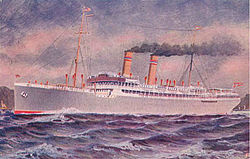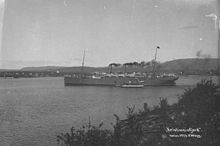Kristianiafjord
|
||||||||||||||||||||||
|
||||||||||||||||||||||
|
||||||||||||||||||||||
|
||||||||||||||||||||||
The Kristianiafjord (I) was a passenger ship of the Norwegian shipping company Den norske Amerikalinje that was put into service in 1913 and operated as a transatlantic liner between Norway and the USA . In June 1917 the ship stranded at Cape Race on the coast of Newfoundland and sank a few days later without loss of life.
The ship
The Kristianiafjord was the first ship of the Norwegian shipping company Den Norske Amerikalinje A / S (NAL), founded in 1910, which was known in the English-speaking world as Norwegian-America Line . She had an identical sister ship , the Bergensfjord , which was put into service shortly after her. Both ships were designed as passenger and cargo ships and built by the shipyard Cammell, Laird & Company in the English port city of Birkenhead . The Kristianiafjord (construction number 784) was launched on November 23, 1912 and the Bergensfjord (construction number 787) on April 8, 1913.
The 10,699 GRT large, steel-built steamship Kristianiafjord was 156.08 meters long, 18.65 meters wide and had a maximum draft of 8.96 meters. It was powered by two eight-cylinder quadruple expansion steam engines, also manufactured by Cammell, Laird and Company, with an output of 1,469 hp . The ship had two propellers , two masts and two funnels. The top speed was 15 knots. The coal was burned in eight single-end steam boilers with a total of 32 furnaces. The hull was divided into watertight compartments by eight bulkheads . The ship was equipped with electric lights, wireless radio and a double floor.
The luxurious passenger accommodation on the Kristianiafjord offered space for 1200 travelers, including 100 in first, 250 in second and 850 in third class. In May 1913 the Kristianiafjord was handed over to her owners and on June 4, 1913 she sailed under the command of Captain SC Hiortdahl in Oslo on her maiden voyage via Kristiansand , Stavanger and Bergen to New York . This was the usual route for their shipping company. The ships of the NAL steamed directly from Norway to New York without detour, without going to continental European ports. This method was new and cut travel time from up to four weeks to one week. It was a fundamental factor in the success of the shipping company.
On June 15, 1917, the Kristianiafjord ran aground with 1,144 people on board due to a navigational error at Mistaken Point, seven nautical miles west of Cape Race on the Newfoundland coast . All passengers and crew could safely leave the ship. The steamer was stuck on the bank until two weeks later, on June 28, 1917, it was destroyed in a storm.

